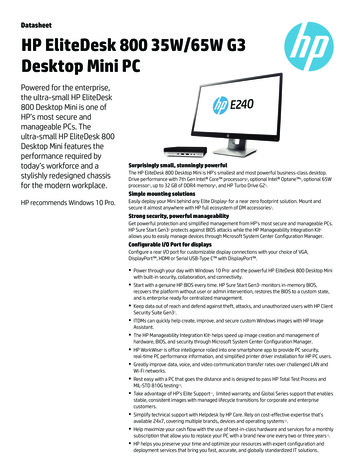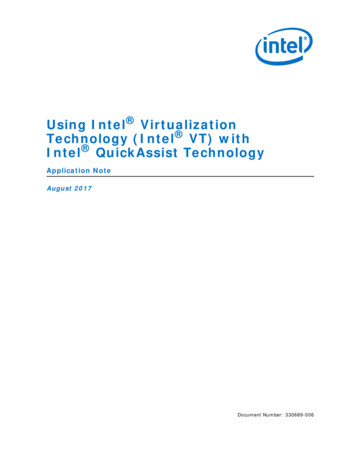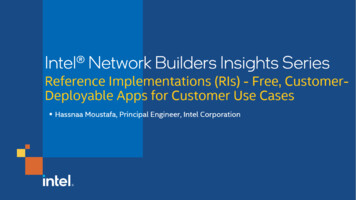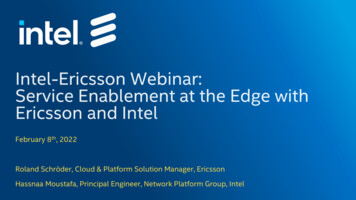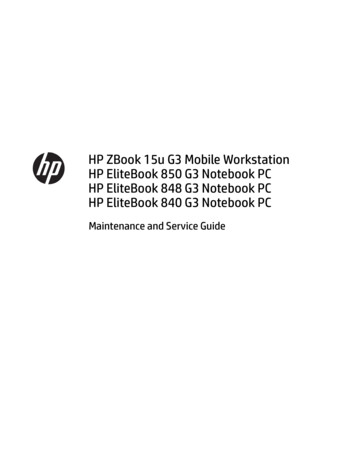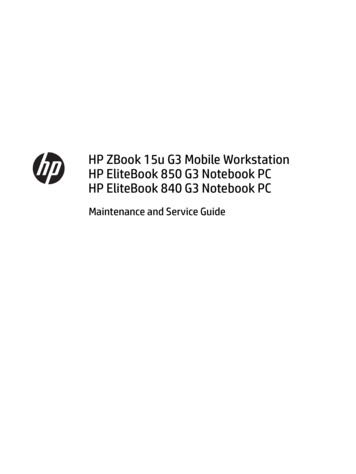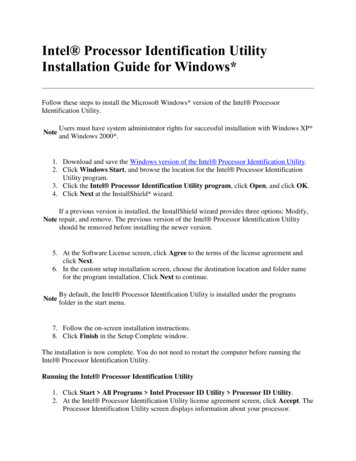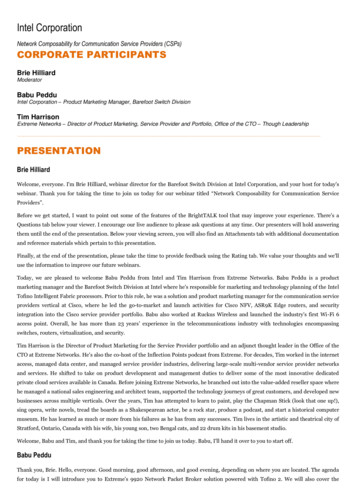
Transcription
Intel CorporationNetwork Composability for Communication Service Providers (CSPs)CORPORATE PARTICIPANTSBrie HilliardModeratorBabu PedduIntel Corporation – Product Marketing Manager, Barefoot Switch DivisionTim HarrisonExtreme Networks – Director of Product Marketing, Service Provider and Portfolio, Office of the CTO – Though Leadership.PRESENTATIONBrie HilliardWelcome, everyone. I'm Brie Hilliard, webinar director for the Barefoot Switch Division at Intel Corporation, and your host for today'swebinar. Thank you for taking the time to join us today for our webinar titled “Network Composability for Communication ServiceProviders”.Before we get started, I want to point out some of the features of the BrightTALK tool that may improve your experience. There's aQuestions tab below your viewer. I encourage our live audience to please ask questions at any time. Our presenters will hold answeringthem until the end of the presentation. Below your viewing screen, you will also find an Attachments tab with additional documentationand reference materials which pertain to this presentation.Finally, at the end of the presentation, please take the time to provide feedback using the Rating tab. We value your thoughts and we'lluse the information to improve our future webinars.Today, we are pleased to welcome Babu Peddu from Intel and Tim Harrison from Extreme Networks. Babu Peddu is a productmarketing manager and the Barefoot Switch Division at Intel where he's responsible for marketing and technology planning of the IntelTofino Intelligent Fabric processors. Prior to this role, he was a solution and product marketing manager for the communication serviceproviders vertical at Cisco, where he led the go-to-market and launch activities for Cisco NFV, ASR9K Edge routers, and securityintegration into the Cisco service provider portfolio. Babu also worked at Ruckus Wireless and launched the industry's first Wi-Fi 6access point. Overall, he has more than 23 years’ experience in the telecommunications industry with technologies encompassingswitches, routers, virtualization, and security.Tim Harrison is the Director of Product Marketing for the Service Provider portfolio and an adjunct thought leader in the Office of theCTO at Extreme Networks. He's also the co-host of the Inflection Points podcast from Extreme. For decades, Tim worked in the internetaccess, managed data center, and managed service provider industries, delivering large-scale multi-vendor service provider networksand services. He shifted to take on product development and management duties to deliver some of the most innovative dedicatedprivate cloud services available in Canada. Before joining Extreme Networks, he branched out into the value-added reseller space wherehe managed a national sales engineering and architect team, supported the technology journeys of great customers, and developed newbusinesses across multiple verticals. Over the years, Tim has attempted to learn to paint, play the Chapman Stick (look that one up!),sing opera, write novels, tread the boards as a Shakespearean actor, be a rock star, produce a podcast, and start a historical computermuseum. He has learned as much or more from his failures as he has from any successes. Tim lives in the artistic and theatrical city ofStratford, Ontario, Canada with his wife, his young son, two Bengal cats, and 22 drum kits in his basement studio.Welcome, Babu and Tim, and thank you for taking the time to join us today. Babu, I'll hand it over to you to start off.Babu PedduThank you, Brie. Hello, everyone. Good morning, good afternoon, and good evening, depending on where you are located. The agendafor today is I will introduce you to Extreme’s 9920 Network Packet Broker solution powered with Tofino 2. We will also cover the
Intel CorporationCorrected TranscriptNetwork Composability for Communication Service Providers (CSPs)networking challenges the telco industry is facing today. I will also introduce to you and walk you over the Intel Data Center of theFuture, Intel Intelligent Fabric vision. We will also cover Intel Intelligent Fabric processors, and we will end the first part of the webinarwith Intel Tofino product family.OK, the Extreme 9920 enables cloud native visibility solution with Network Packet Broker application. It provides a composable datapipeline that allows maximum flexibility for future enhancements of the networks. Extreme Networks is one of the first customers todeploy Intel Tofino 2 programmable Ethernet Switch ASICs. The Extreme 9920 Network Packet Broker solution is deployed in large 5Gmobile networks of many service providers. Extreme projects are huge opportunities for the solution over the next few years. We willcover a little in depth of the solution in the second part of the webinar.Now, let's look at some of the key networking challenges the industry is facing today. Many enterprises have moved to the cloud inlarge. As a result, the service providers are also experiencing a need to move to the cloud. Bottom line, all the data traffic is moving tothe cloud. We are generating data at a very faster rate than our ability to analyze, interpret, transmit, secure, and reconstruct in realtime. The analysts from IDC, they are anticipating by 2025 there will be at least 175 zettabytes of data that will be floating around in allsorts of networks-- cloud, hybrid, private, and other on-premise data centers.So, moving to the cloud native architecture will require container-based processing, orchestration, and automation. Moreover, as theworkloads are distributed across multiple cloud environments like public, private, or even hybrid, we will need to manage all this dataacross all these providers. The current architectures are not adequate enough to scale to cater to that. We will need more modernizedarchitectures. AI and changing workloads will spawn need for growing network optimizations to reduce the troubleshooting time of anyissue in a given network.Security. The network perimeter is growing, and as the networks evolve, threats evolve too. The traditional methods of firewalling,distributed denial of services, advanced malware protection, intrusion detection and prevention, they are not just enough. We will needto come up with better security techniques. All these issues coupled together, combined together, are causing operational challenges forthe IT administrators and also the network administrators. This is resulting in root causing to the network slowdowns. This is alsoincreasing the capital expenditure, operational expenditure, and investments for service providers. It's time to change the way thenetworks are built. It's time to stop solving the future problems with older techniques. We will need networks that are smarter, agile,intelligent, that can provide increased bandwidth.To overcome these challenges, Intel came up with the Data Center of the Future. New times, new problems, new solutions, Intel isbuilding a Data Center of the Future. The Data Center of the Future has three categories. One is CPU for general purpose computing,number two, Intel XPUs for workload or application-specific acceleration, and three, IPU, infrastructure processing unit, to acceleratethe infrastructure. The IPU is a secure programmable networking device that will increase the visibility, that will increase theperformance, and reduce the overhead in the CPU. It will also allow to utilize and balance the resources between storage and computewithin this architecture. All of these vectors that you'll see on either side, these critical components, are connected through IntelIntelligent Fabric that you see in the middle. So, let's talk a little bit about the Intel Intelligent Fabric.Intel's vision to address these networking needs as part of the Data Center of the Future is the Intel Intelligent Fabric with optimizedconnections. Though targeted at cloud data centers, it can also be leveraged for Edge data centers, high performance computing, andcommunication service providers adopting cloud native technologies.The Intel Intelligent Fabric is based on the Leaf-Spine topology. So, it brings together a comprehensive portfolio of Intel SiliconPhotonics, Intel Tofino switching products, Intel IPUs, Intel Network Ethernet adapters, Intel scalable Xeon processors, Intel Agilex,Intel eASIC, Habana, and all. So, this will all provide extra visibility, added intelligence, and improves the performance. Intel is alsotaking leadership in bringing the industry standards together, the P4 programmability, SPDK, storage performance developer kit,EBPF, DPDK, and for the networking OS, the SONiC OS, OCP SONiC OS, and also the IPDK, infrastructure programmabledevelopment kit. These are all open source standards that Intel is planning to bring together and building a leadership role here, so that2 of 9
Intel CorporationCorrected TranscriptNetwork Composability for Communication Service Providers (CSPs)angle is ease of use, massive bandwidth, AI-driven self-monitoring, self-analyzing, self-healing, self-remediating networks, it increasesthe security, it enables end-to-end optimization with in-band telemetry. It improves the density, optimizes power, reduces the costs.Now, let's move onto the next slide. So, at the heart of the Intel Intelligent Fabric is the Intel Tofino 3 Intelligent Fabric processor. Weannounced this a little over a month before at the Intel Innovation event. The explosion in new services like 5G, IoT, augmented reality,virtual reality, AI/ML will require unquenchable bandwidth demand for unquenchable bandwidth. The current data centers haveoutgrown and cannot scale to these new services. We cannot solve future problems with older techniques. The Tofino 3 bringsintelligence through P4 programmability and AI/machine learning acceleration. This will also increase the performance up to 25.6 Tbpsusing a 56 or 112 gigabits per second service. This also brings extensive visibility and control using in-band telemetry and Intel DeepInsight Network Analytics Software. With IFP, it’s not just the cloud data centers that will benefit, but also the Edge data centers, highperformance computing platforms, communication service providers, everyone, whoever will adopt cloud technologies.So, Intelligent key benefit vectors. Key benefits fall into three major buckets or benefit vectors—intelligence, performance, visibility andcontrol. So, under intelligence, we have a fully customizable P4 programmable pipeline. Intelligent packet processing for acceleratingAI/ML workloads. Expandable table and buffer sizes with Intel FPGAs. Enhanced security with Intel Software Guard Extension withIntel Trust Domain Extensions. Performance, we have multiple form factors, 6.4, 4.8, 25.6 Tbps total throughput. It comes with 112 or56G SerDes for high speed and easy migration. It provides high speed Intel Silicon Photonics. It provides power-optimized hyperscaleruse cases for Intel Tofino Intelligent Fabric processors. Visibility and control provides enhanced congestion control. It identifies delaysor hotspots with real-time in-band telemetry. It analyzes the packet flows with Deep Insight Network Analytics Software. It providesremedy using AI or Deep Insight reports. It performs traffic monitoring and steering for enhanced security and reliable transport. Itprovides an increased in-band telemetry data available with the Intel IPUs and Ethernet network adapters.So, I wanted to present you the Intel Tofino product family roadmap slide. So, we have three form factors here. The first generationTofino comes with 16 nanometers with up to 1.8 to 6.4 Tbps, has 24 gigabits SerDes, and then a second form factor is Tofino 2 withseven nanometers, provides speed up to 4.8 to 12.8 Tbps, it has a modular chip design and has 56G SerDes. The third form factor isTofino 3 with seven nanometers, which is built on the same architecture as Tofino 2. It comes from 6.4 to 25.6 Tbps, has the samemodular chip design, and SerDes is 112G and 56G. It provides intelligence with P4 programmable AI/ML acceleration and really highlysecure. Performance, it provides up to 25.6 Tbps throughput with IFP, 112G/56G SerDes for Tofino 3. Visibility and control, as wespoke earlier, edgeo-to-cloud real telemetry, that is one of the features, provides enhanced congestion control, and also enables selfhealing network capabilities. The networks will be able to remediate any issues automatically.So, with that being said, folks, I will pass on the baton to my partner, Tim. Tim, please go ahead.Tim HarrisonThanks very much, Babu, and thanks so much, Brie, for getting this all set up. Good morning, good afternoon, and good evening,everyone. Forgive my long intro. I'll skip further details and jump right in.First of all, thank you for spending some of your valuable time with us today. We really appreciate it. I loved one of the things that Babusaid earlier-- well, all of the things about Babu said earlier, but in particular, as he was speaking, he said networks solving problems forthe future can't use techniques from the past. I think that's really insightful. So, let's talk about how some of that has changed over thepast little while.As we all know, 5G for communication service providers has become the standard and the goal going forward, and that rollout wasactually going fairly well, we were seeing some good transition into that, and it was really starting to blossom, and then along cameCOVID. So, we all know what COVID has done to our lives and to the business models of service providers. So, what does this mean forExtreme in the new world, and what has changed culturally and socially that changes the nature of 5G deployments and othertechnologies requiring visibility?3 of 9
Intel CorporationCorrected TranscriptNetwork Composability for Communication Service Providers (CSPs)Well, the thing that we've discovered is that service providers need to be moving faster than their customers. Networks must adjust fornew use cases as they appear. Operators need to be able to see changes coming and to react before those changes impact theircustomers or degrade their services. We've all heard the standard 5G use cases, and we feel that those are definitely starting to develop,but I believe that the killer apps for 5G are still to come. How does a service provider build a network for the long-term now, and havethe flexibility to change when something changes our lives again? Back to what Babu said earlier about networks solving problems forthe future, can't use techniques from the past. So, what is the story that we're telling to help address this?Well, we are telling the story of composability. There are some different concepts of composability out there. Some believe that it'sprimarily resource management. We see it slightly differently. So, we're designing everything with our forthcoming solutions to becomposable. Composability really enables a service provider to adapt to changing use cases by defining how they wish to use theirinfrastructure. The power to change how packets are processed through that data pipeline. The flexibility to enable, migrate, anddisable features with the click of a button. The depth of visibility anywhere within the network. The freedom to use the infrastructure todeliver new services without rip and replace of the infrastructure. And all of this is enabled by the power of cloud native technologies.That means that a service provider can change the nature or recompose their services based on the use cases that they see identifiedthrough our visibility tools, actioned through our automation, delivered, managed, and assured through our platforms, and enabled bythe ability to scale anywhere. Look at this as the leveling up of the hardware abstraction layer to a network abstraction layer that turnsthe network into a platform onto which you can then compose applications. We don't want to just focus on the technologies underlyingthe network, but really on composing what is service delivery on top of the network. And this is really important for 5G. As we see thoseuse cases build, we want to make sure that service providers are building a network for the long-term now, and have the flexibility tochange when something changes our lives again. This is why composability is vital for the service provider network at scale.So, speaking of scale, when we talk about scale, and when we talk about things like infinite distribution, we really mean at scale, and inso many ways, infinitely distributed. Think about 5G as a model for incredible scale, not only in bandwidth that's usable by theconsumer, but also from an infrastructure standpoint. So, we have a picture here of a tower on top of a mountain, think of the truckrolls when something goes wrong, think of the management complexity of having network devices spread throughout the landscapethat are either at Extreme’s scale or distant, but also the ability to scale the resources to manage and to configure and to compose thatnetwork. So, we're traditionally focused on horizontal and vertical scale. We think about this as more of a circumference of scale whereeverything is distributed significantly out rather than centralized deep in the heart of data centers. So, we want to make sure that whenwe talk about scale, we understand the nature of scale, specifically in 5G and cloud networks.And speaking of cloud, service providers are at different points along the cloud path. The key is that if a service provider does not have astrategy for cloud or cloud native technologies, they're in trouble. We want to be able to help service providers understand the value ofcloud and cloud native technologies, and for Extreme, who has often been known as an enterprise business, when we talk about cloud,we mean more than just our enterprise wired and wireless management platforms. Those are absolutely key, and they have been hugevalues for Extreme, but what we see is that the cloud native technologies underlying those are the real key to composability andconsumption at scale, and in an infinitely distributed world. Now, think about the 5G proof points. We've seen AT&T leverage Azure for5G. We've seen Bell Canada going to GCP to manage their virtual infrastructure, Microsoft Azure for Operators, for example, and eventhe AWS enterprise cellular or enterprise 5G announcements that we've just seen, cloud makes a huge difference, and people arestarting to understand the value that they can gain from cloud native technologies. We've certainly seen that within our ownorganization, as we've pivoted to more of a software standpoint to allow our customers to actually start using these technologies and tochange the way that they do business. So, I think you're going to see some amazing new solutions from Extreme built on cloud nativetechnologies for the service provider, and we're going to talk about one of those today.So, today, we're going to focus on visibility. So, without the ability to know what's actually happening in your network at any given time,it's extremely hard to make effective decisions on service delivery. For Extreme, visibility is about having the ability to help you makedecisions, the best decisions possible, by getting network data consumed, processed, and off to analytics tools at speed, and at scale.4 of 9
Intel CorporationCorrected TranscriptNetwork Composability for Communication Service Providers (CSPs)When we look at the key ways that we can help you today, we feel that we deliver an industry-leading flexibility. So, this is ourcomposability story. The ability to compose not only the software, but also the Intel Tofino 2 chipset that we use using P4. To enableCSPs to scale anywhere through automation and simplified management. Again, when we look at that circumference of scale, and welook at how infrastructure is going to be in any place necessary to provide services, you need to be able to manage that, and managing itindividually as you might do today on certain network management apps is not going to be the way to do it. We need to be able to do itin a better way to allow you to scale not only your network, but your resources to manage that network. And the power of visibilityacross highly distributed physical and virtual environments is vital, as we look at composing the applications. That means we need to beable to push visibility to wherever you need it in the network, and that means that it may live inside of virtual environments. That maybe in private cloud, it may be just in a virtualization stack, where there's a MEC stack somewhere at the base of a cell tower. We need tobe able to get visibility into there, and that takes multiple types of form factors from the physical to the virtual.So, what are the key tenets, if you will, of our network visibility solution today? Well, we have at the top layer, if you will, ExtremeVisibility Manager. This is a centralized management tool for all of our visibility solutions. That includes legacy tools that we have,legacy platforms that we have, that have been great tools and resources within major service provider networks today, and also what wehave going forward. We don't want to strand anybody because the technology has been working for a period of time, and they still needto get value out of that. So, we continue to be able to manage not only existing platforms, but platforms going forward.The second is the Composable Network Operating System. So, this is really a key element of the strategy. We need to be able tocompose not only the application in microservice form, but we also need to be able to be focused on customization of that platform andthe ability to deliver rapidly. So, using those cloud native technologies that we talked about, microservices inside of containers forexample, this allows us to be more effective and more efficient with the platforms that we deliver for the composable network andvisibility. And the Extreme Network Visibility Platform, so this is some hardware, some software, and some chip that is built for a cloudnative world. So, literally with the operating system, and with the tools that we use on top of that platform, this is a cloud nativeapplication, and the application that runs on top of that platform that we're talking about today is our Network Packet Brokerapplication, and this is very key. This is where Intel and Extreme are attached at the hip. This platform is fundamentally built using theIntel Tofino 2. Now, we are in love with the Tofino 2. It allows us to do things that our competition cannot do and cannot catch up to uswith. We think we've leapfrogged them with the use of the Intel Tofino 2 chip.Extreme Visibility Manager, so often, when we talk about service providers, we think of CLI junkies who loves to get in there and typeand spend time scripting things. That's true, and I come from that world, and some days I miss scripting those types of things.However, when we think about what the things that people need to accomplish are, we find that the CLI is just the end result, and wedon't want to focus on-- sorry, the end step, we don't want to focus on the end step. We want to focus on the end result. So, how can wemake it easier for somebody who is administering one of these visibility networks or configurations or deployments? We want to givethem the easiest, most user-centric experience as we possibly can, leveraging the tools that we have. It's very complex to manage a typeof environment like this without having data about that environment as well. So, we have streaming platform telemetry. As Babumentioned, there's lots of telemetry that comes from the chip, and comes from the architecture itself, that we can feed back into theapplication, allowing the application to give a constant update on the readiness and power and availability of the visibility platform.The key value prop here, this improves productivity, simply just by lowering the time it takes to build the infrastructure rule sets and tomanage the applications that are delivered out onto the network, and that reduces operating costs. It also reduces risk. So, when youhave a bunch of humans doing individual tasks, there's an increased risk. When you have tools that allow more intuitive access toconfiguration, there's less opportunity for mistakes, there's less opportunity for somebody to miss something, and that reduces risk,which overall reduces costs. We think that's really important to understand.So, let me show you the fruits of our labors from a platform perspective. This is the Extreme 9920 that Babu mentioned previously. So,this platform is fully composable. This is from the chip level, all the way up to the operating system, all the way up to the managementfrom Extreme Management Center. It's also all built on cloud native technologies. Extreme Visibility Manager has been built on cloud5 of 9
Intel CorporationCorrected TranscriptNetwork Composability for Communication Service Providers (CSPs)native technologies. Therefore, it’s composable all the way down to the chip. Always, we're focused on the most powerful packetvisibility possible and we've worked very hard to make sure that we are providing the best slicing and dicing of those packets possible,and making sure that we have incredible performance, and that Intel Tofino 2 chip gives us the ability to do more with the platform andto do it at speed. So, very important for us.And as part of the overall cloud native visibility, there is obviously the Extreme 9920 in the center, but we have Extreme VisibilityManager. We also have Extreme Session Director, which is useful in LTE and 4G/5G networks. We have the SLX 9140/9240, which arekey collectors and aggregators inside of the network, but again, as we talked about physical and virtual, the key is that we do havevirtual packet broker applications that can be orchestrated out to those virtualized environments. All of this, of course, is builtleveraging our BGP-EVPN configurations, on top of Edge infrastructure, and is supported by powerful automation. We have ourExtreme Fabric Automation tool, which is sometimes actually built into the platform on certain switches, but allows you to very easilycreate your configurations to interconnect all of your devices together, allowing you to have that visibility network instantiated on top ofeither your existing network or instantiating a visibility network that is separate from your production infrastructure.Just to show you where that fits in our product line, so we have our IP Fabric tools and our IP Fabric switches. Those are very powerfulEdge and MEC and data center switching architectures. We also have our border routing platforms, also our IP transit, but key to thisis, of course, our cloud native visibility quadrant at the bottom you see there. So, this is a very holistic architecture. There are tools thatfit each of the different types of use cases, some of them blend across. We also have our trusted delivery initiative where we have somevery protected risk mitigation, factory to production, and full lifecycle management type of switches for those that are concerned aboutsupply chain and nefarious activity there.So, to get more information on powering our visibility solutions together with Intel, we have some resources on our solution/visibilitypage. There's also a fantastic blog written by my co-worker, and also my question gatherer today, Joerg Bonarius, and you can get morein-depth architecture information there on how it is that this platform can be designed to fit into your architecture, and thatarchitecture can be used to make sure that you're making more money, you're making sure that you're addressing your solutions atscale, with infinite distribution, and in a consumer-centric way, so that you're focused on what it is you're delivering for customers, andthe Intel platforms have been absolutely fantastic. We have the ability to do things that others cannot do, because we focused onworking with Intel on this. And I also want to make sure that you understand the nature of the composability here. This Network PacketBroker application that runs on top of the 9920 is the same packet broker application that can be imposed and moved into differentother platforms. The 9920 is a perfectly enabled solution to be able to process those packets at scale at extreme speed. Thank you forIntel's Tofino 2 chipset, and the pun there. But this gives us the performance in large scale environments, cloud service providers, andcommunication service providers, and we have the ability to feed that through the rest of our visibility platform and to be able tomanage it at scale through our Extreme Visibility Manager.So, I want to thank you all for listening, and I will turn this back over to Brie who will take us through to our questions.Brie HilliardGreat, thank you both so much for that excellent presentation. Tim just shared several links, and I just want to direct everyone to theAttachments tab that's right below your screen. You'll be able to find all of those links and attachments easily accessible right there.Now, let's get into the Q&A. The first question I have is for Babu. So, Babu-- let's see, bear with me one second. Babu, is the Tofino 3IFP targeted only at data centers? Can it provide benefit in any other deployments?Babu PedduThe Tofino 3 is not just for cloud data centers that it will benefit, but also the Edge data centers, high performance computing, andcommunication service providers, all who are adopting cloud native technologies, so all of them can benefit out of it.6 of 9
Intel CorporationCorrected TranscriptNetwork Composability for Communication Service Providers (CSPs)Brie HilliardGreat, thanks so muc
Intel Corporation - Product Marketing Manager, . Enhanced security with Intel Software Guard Extension with Intel Trust Domain Extensions. Performance, we have multiple form factors, 6.4, 4.8, 25.6 Tbps total throughput. It comes with 112 or 56G SerDes for high speed and easy migration. It provides high speed Intel Silicon Photonics.

